On the Lanthanide Effect on Functional Properties of 0.94Na0.5Bi0.5TiO3-0.06BaTiO3 Ceramic
Abstract
:1. Introduction
2. Materials and Methods
3. Results and Discussion
3.1. X-ray Diffraction and Structural Analysis
3.2. Raman Spectra
3.3. Dielectric Studies
3.4. Ferroelectric Performance
3.5. Photoluminescence (PL) Investigations
- x and y represent the CIE coordinates of the entire spectrum.
- xs and ys denote the the CIE coordinates of the standard illuminants of white light.
- xd and yd stand for the CIE coordinates of the dominant wavelength.
4. Conclusions
Author Contributions
Funding
Institutional Review Board Statement
Informed Consent Statement
Data Availability Statement
Conflicts of Interest
References
- Zhang, H.; Jiang, S.; Kajiyoshi, K.; Xiao, J. Dielectric, Ferroelectric, Pyroelectric, and Piezoelectric Properties of La-Modified Lead-Free Sodium-Potassium Bismuth Titanate Thick Films. J. Am. Ceram. Soc. 2010, 93, 750–757. [Google Scholar] [CrossRef]
- Niranjan, M.K.; Karthik, T.; Asthana, S.; Pan, J.; Waghmare, U.V. Theoretical and experimental investigation of Raman modes, ferroelectric and dielectric properties of relaxor Na0.5Bi0.5TiO3. J. Appl. Phys. 2013, 113, 194106. [Google Scholar] [CrossRef]
- Nagata, H.; Yoshida, M.; Makiuchi, Y.; Takenaka, T. Large Piezoelectric Constant and High Curie Temperature of Lead-Free Piezoelectric Ceramic Ternary System Based on Bismuth Sodium Titanate-Bismuth Potassium Titanate-Barium Titanate near the Morphotropic Phase Boundary. Jpn. J. Appl. Phys. 2003, 42, 7401–7403. [Google Scholar] [CrossRef]
- Kuharuangrong, S. Effect of La and K on the microstructure and dielectric properties of Bi0.5Na0.5TiO3-PbTiO3. J. Mater. Sci. 2001, 36, 1727–1733. [Google Scholar] [CrossRef]
- Panda, P.K. Review: Environmental friendly lead-free piezoelectric materials. J. Mater. Sci. 2009, 44, 5049–5062. [Google Scholar] [CrossRef]
- Smail, S.; Benyoussef, M.; Taïbi, K.; Bensemma, N.; Manoun, B.; El Marssi, M.; Lahmar, A. Structural, dielectric, electrocaloric and energy storage properties of lead free Ba0.975La0.017(ZrxTi0.95−x)Sn0.05O3 (x = 0.05; 0.20) ceramics. Mater. Chem. Phys. 2020, 252, 123462. [Google Scholar] [CrossRef]
- Kanuru, S.R.; Baskar, K.; Dhanasekaran, R. Synthesis, structural, morphological and electrical properties of NBT–BT ceramics for piezoelectric applications. Ceram. Int. 2016, 42, 6054–6064. [Google Scholar] [CrossRef]
- Chu, B.-J.; Chen, D.-R.; Li, G.-R.; Yin, Q.-R. Electrical properties of Na1/2Bi1/2TiO3–BaTiO3 ceramics. J. Eur. Ceram. Soc. 2002, 22, 2115–2121. [Google Scholar] [CrossRef]
- Xu, Q.; Li, T.; Hao, H.; Zhang, S.; Wang, Z.; Cao, M.; Yao, Z.; Liu, H. Enhanced energy storage properties of NaNbO3 modified Bi0.5Na0.5TiO3 based ceramics. J. Eur. Ceram. Soc. 2015, 35, 545–553. [Google Scholar] [CrossRef]
- Zvirgzds, J.A.; Kapostin, P.P.; Zvirgzde, J.V.; Kruzina, T.V. X-ray study of phase transitions in efrroelectric Na0.5Bi0.5TiO3. Ferroelectrics 1982, 40, 75–77. [Google Scholar] [CrossRef]
- Takenaka, T.; Kei-ichi Maruyama, K.M.; Koichiro Sakata, K.S. (Bi1/2Na1/2)TiO3-BaTiO3 System for Lead-Free Piezoelectric Ceramics. Jpn. J. Appl. Phys. 1991, 30, 2236. [Google Scholar] [CrossRef]
- Kandula, K.R.; Banerjee, K.; Raavi, S.S.K.; Asthana, S. Enhanced Electrocaloric Effect and Energy Storage Density of Nd-Substituted 0.92NBT-0.08BT Lead Free Ceramic. Phys. Status Solidi A 2018, 215, 1700915. [Google Scholar] [CrossRef]
- Liu, M.; Lei, F.; Jiang, N.; Zheng, Q.; Lin, D. Enhanced piezoelectricity, bright up-conversion and down-conversion photoluminescence in Er3+ doped 0.94(BiNa)0.5TiO3–0.06BaTiO3 multifunctional ceramics. Mater. Res. Bull. 2016, 74, 62–69. [Google Scholar] [CrossRef]
- Li, Q.; Wang, J.; Ma, L.; Fan, H.; Li, Z. Large electrocaloric effect in (Bi0.5Na0.5)0.94Ba0.06TiO3 lead-free ferroelectric ceramics by La2O3 addition. Mater. Res. Bull. 2016, 74, 57–61. [Google Scholar] [CrossRef]
- Chen, Z.-H.; Ding, J.-N.; Lin, M.; Yuan, N.; Zhu, Y.-Y. Piezoelectric and dielectric properties of Dy2O3-doped (Bi0.5Na0.5)0.94Ba0.06TiO3 lead-free ceramics. J. Alloys Compd. 2011, 509, 482–485. [Google Scholar] [CrossRef]
- Khatua, D.K.; Agarwal, A.; Kumar, N.; Ranjan, R. Probing local structure of the morphotropic phase boundary composition of Na0.5Bi0.5TiO3–BaTiO3 using rare-earth photoluminescence as a technique. Acta Mater. 2018, 145, 429–436. [Google Scholar] [CrossRef]
- Sankaran, S.S.; Dhanasekaran, R.; Kumar, B.; Durairajan, A.; Valente, M.A.; Stephen, L.D. Study on growth, optical and dielectric properties of ‘Nd’ DOPED NBT-BT (0.94(Na0.5Bi0.5TiO3)-0.06BaTiO3) relaxor ferroelectric single crystals. J. Electroceram. 2022, 48, 143–156. [Google Scholar] [CrossRef]
- Khatua, D.K.; Kalaskar, A.; Ranjan, R. Tuning Photoluminescence Response by Electric Field in Electrically Soft Ferroelectrics. Phys. Rev. Lett. 2016, 116, 117601. [Google Scholar] [CrossRef] [PubMed]
- Wu, N.; Pang, D.; Liang, T.; He, X. Ferroelectric properties and large electric field-induced strain of Eu3+-doped Na0.5Bi0.5TiO3–BaTiO3 lead-free ceramics. Ceram. Int. 2022, 48, 23481–23491. [Google Scholar] [CrossRef]
- Kacem, H.; Dhahri, A.; Sassi, Z.; Seveyrat, L.; Lebrun, L.; Perrin, V.; Dhahri, J. Relaxor characteristics and pyroelectric energy harvesting performance of BaTi0.91Sn0.09O3 ceramic. J. Alloys Compd. 2021, 872, 159699. [Google Scholar] [CrossRef]
- Travis, W.; Glover, E.N.K.; Bronstein, H.; Scanlon, D.O.; Palgrave, R.G. On the application of the tolerance factor to inorganic and hybrid halide perovskites: A revised system. Chem. Sci. 2016, 7, 4548–4556. [Google Scholar] [CrossRef]
- Chchiyai, Z.; El Bachraoui, F.; Tamraoui, Y.; Haily, E.M.; Bih, L.; Lahmar, A.; Alami, J.; Manoun, B. Design, structural evolution, optical, electrical and dielectric properties of perovskite ceramics Ba1−xBixTi1−xFexO3 (0 ≤ x ≤ 0.8). Mater. Chem. Phys. 2021, 273, 125096. [Google Scholar] [CrossRef]
- Koduri, R.; Hermosilla, L.S. Effect of Ba on ferroelectric and piezoelectric properties of the PLZT (1.2/55/45) system. Phys. Status Solidi A 2006, 203, 2119–2127. [Google Scholar] [CrossRef]
- Zidani, J.; Zannen, M.; Hadouchi, M.; Alzahrani, H.A.H.; Birks, E.; Khemakhem, H.; Majdoub, M.; El Marssi, M.; Lahmar, A. Structural, electrical and optical properties of Lanthanide-doped Na0.4K0.1Bi0.5TiO3 ceramics. Phys. B Condens. Matter. 2023, 653, 414680. [Google Scholar] [CrossRef]
- Xiao, D.Q.; Lin, D.M.; Zhu, J.G.; Yu, P. Studies on new systems of BNT-based lead-free piezoelectric ceramics. J. Electroceram. 2008, 21, 34–38. [Google Scholar] [CrossRef]
- Suchanicz, J.; Lewczuk, U.; Konieczny, K. Effect of Ba doping on the structural, dielectric and ferroelectric properties of Na0.5Bi0.5TiO3 ceramics. Ferroelectrics 2016, 497, 85–91. [Google Scholar] [CrossRef]
- Chandra Sekhar, K.S.K.R.; Banerjee, K.; Asthana, S.; Patri, T.; Mouli, K.C. Observation of diffuse relaxor activity and normal thermal stability in Ho—Modified NBT—BT lead free ceramics. Ferroelectrics 2020, 568, 161–174. [Google Scholar] [CrossRef]
- Nasser, S.A. Infrared absorption of some perovskite type titanates containing some additives. J. Mater. Sci. Lett. 1990, 9, 1453–1455. [Google Scholar] [CrossRef]
- Aksel, E.; Forrester, J.S.; Foronda, H.M.; Dittmer, R.; Damjanovic, D.; Jones, J.L. Structure and properties of La-modified Na0.5Bi0.5TiO3 at ambient and elevated temperatures. J. Appl. Phys. 2012, 112, 054111. [Google Scholar] [CrossRef]
- Schütz, D.; Deluca, M.; Krauss, W.; Feteira, A.; Jackson, T.; Reichmann, K. Lone-Pair-Induced Covalency as the Cause of Temperature- and Field-Induced Instabilities in Bismuth Sodium Titanate. Adv. Funct. Mater. 2012, 22, 2285–2294. [Google Scholar] [CrossRef]
- Xu, C.; Lin, D.; Kwok, K.W. Structure, electrical properties and depolarization temperature of (Bi0.5Na0.5)TiO3–BaTiO3 lead-free piezoelectric ceramics. Solid State Sci. 2008, 10, 934–940. [Google Scholar] [CrossRef]
- Selvamani, R.; Singh, G.; Sathe, V.; Tiwari, V.S.; Gupta, P.K. Dielectric, structural and Raman studies on (Na0.5Bi0.5TiO3)(1 − x)(BiCrO3)x ceramic. J. Phys. Condens. Matter. 2011, 23, 055901. [Google Scholar] [CrossRef] [PubMed]
- Binnemans, K. Interpretation of europium(III) spectra. Coord. Chem. Rev. 2015, 295, 1–45. [Google Scholar] [CrossRef]
- Chen, P.-Y.; Chen, C.-S.; Tu, C.-S.; Chen, P.-H.; Anthoniappen, J. Effects of texture on microstructure, Raman vibration, and ferroelectric properties in 92.5%(Bi0.5Na0.5)TiO3–7.5%BaTiO3 ceramics. J. Eur. Ceram. Soc. 2016, 36, 1613–1622. [Google Scholar] [CrossRef]
- Chandra Sekhar, K.S.K.R.; Mahesh, M.L.V.; Sreenivasu, T.; Rama Krishna, Y.; Chandra Mouli, K.; Tirupathi, P. Structural evolution, dielectric relaxation and modulus spectroscopic studies in Dy substituted NBT-BT ferroelectric ceramics. J. Mater. Sci. Mater. Electron. 2021, 32, 8628–8647. [Google Scholar] [CrossRef]
- Silva, P.S.; Diaz, J.C.C.A.; Florêncio, O.; Venet, M.; M’Peko, J.C. Analysis of the Phase Transitions in BNT-BT Lead-Free Ceramics Around Morphotropic Phase Boundary by Mechanical and Dielectric Spectroscopies. Arch. Metall. Mater. 2016, 61, 17–20. [Google Scholar] [CrossRef]
- Lv, J.; Li, Q.; Li, Y.; Tang, M.; Jin, D.; Yan, Y.; Fan, B.; Jin, L.; Liu, G. Significantly improved energy storage performance of NBT-BT based ceramics through domain control and preparation optimization. Chem. Eng. J. 2021, 420, 129900. [Google Scholar] [CrossRef]
- Swain, S.; Kumar Kar, S.; Kumar, P. Dielectric, optical, piezoelectric and ferroelectric studies of NBT–BT ceramics near MPB. Ceram. Int. 2015, 41, 10710–10717. [Google Scholar] [CrossRef]
- Dorcet, V.; Trolliard, G.; Boullay, P. Reinvestigation of Phase Transitions in Na0.5Bi0.5TiO3 by TEM. Part I: First Order Rhombohedral to Orthorhombic Phase Transition. Chem. Mater. 2008, 20, 5061–5073. [Google Scholar] [CrossRef]
- Benyoussef, M.; Zannen, M.; Belhadi, J.; Manoun, B.; Kutnjak, Z.; Vengust, D.; Spreitzer, M.; El Marssi, M.; Lahmar, A. Structural, dielectric, and ferroelectric properties of Na0.5(Bi1−xNdx)0.5TiO3 ceramics for energy storage and electrocaloric applications. Ceram. Int. 2021, 47, 26539–26551. [Google Scholar] [CrossRef]
- Turki, O.; Slimani, A.; Seveyrat, L.; Sassi, Z.; Khemakhem, H.; Lebrun, L. Enhancement of dielectric, piezoelectric, ferroelectric, and electrocaloric properties in slightly doped (Na0.5Bi0.5)0.94Ba0.06TiO3 ceramic by samarium. J. Appl. Phys. 2019, 125, 174103. [Google Scholar] [CrossRef]
- Zhang, Q.; Zhao, X.; Sun, R.; Luo, H. Crystal growth and electric properties of lead-free NBT-BT at compositions near the morphotropic phase boundary: Crystal growth and electric properties of lead-free NBT-BT. Phys. Status Solidi A 2011, 208, 1012–1020. [Google Scholar] [CrossRef]
- Chen, C.; Jiang, X.; Li, Y.; Wang, F.; Zhang, Q.; Luo, H. Growth and electrical properties of Na1/2Bi1/2TiO3–BaTiO3 lead-free single crystal with morphotropic phase boundary composition. J. Appl. Phys. 2010, 108, 124106. [Google Scholar] [CrossRef]
- Badapanda, T.; Sahoo, S.; Nayak, P. Dielectric, Ferroelectric and Piezoelectric study of BNT-BT solid solutions around the MPB region. IOP Conf. Ser. Mater. Sci. Eng. 2017, 178, 012032. [Google Scholar] [CrossRef]
- Zhang, Q.; Yang, T.; Zhang, Y.; Wang, J.; Yao, X. Enhanced antiferroelectric stability and electric-field-induced strain properties in rare earth-modified Pb(Zr0.63Sn0.26Ti0.11)O3 ceramics. Appl. Phys. Lett. 2013, 102, 222904. [Google Scholar] [CrossRef]
- Turki, O.; Slimani, A.; Abdelmoula, N.; Seveyrat, L.; Sassi, Z.; Khemakhem, H.; Lebrun, L. Lanthanides effects on the ferroelectric and energy-storage properties of (Bi0.5Na0.5)0.94Ba0.06TiO3 ceramic: Comparative approach. Solid State Sci. 2021, 114, 106571. [Google Scholar] [CrossRef]
- Ismail, F.A.; Osman, R.A.M.; Idris, M.S. Review on dielectric properties of rare earth doped barium titanate. AIP Conf. Proc. 2016, 1756, 090005. [Google Scholar] [CrossRef]
- Borkar, H.; Singh, V.N.; Singh, B.P.; Tomar, M.; Gupta, V.; Kumar, A. Room temperature lead-free relaxor–antiferroelectric electroceramics for energy storage applications. RSC Adv 2014, 4, 22840–22847. [Google Scholar] [CrossRef]
- Zhou, T.; Zheng, D.-Y.; Peng, G.-G.; Peng, Z.-H.; Zhang, N. Effects of (Bi0.5Na0.5)ZrO3 addition on relaxation behavior and electrical properties of the KNN–LS ceramics. J. Mater. Sci. Mater. Electron. 2018, 29, 1131–1138. [Google Scholar] [CrossRef]
- Peláiz-Barranco, A.; González-Carmenate, I.; Calderón-Piñar, F. Relaxor behaviour in PZN–PT–BT ferroelectric ceramics. Solid State Commun. 2005, 134, 519–522. [Google Scholar] [CrossRef]
- Cai, W.; Fu, C.; Gao, J.; Deng, X. Effect of Mn doping on the dielectric properties of BaZr0.2Ti0.8O3 ceramics. J. Mater. Sci. Mater. Electron. 2010, 21, 317–325. [Google Scholar] [CrossRef]
- Peng, G.-G.; Zheng, D.-Y.; Hu, S.-M.; Zhao, H.; Cheng, C.; Zhang, J. Effects of rare-earth Sm2O3 addition on relaxation behavior and electric properties of 0.5PNN-0.5PZT ceramics. J. Mater. Sci. Mater. Electron. 2016, 27, 5509–5516. [Google Scholar] [CrossRef]
- Xu, Q.; Chen, M.; Chen, W.; Liu, H.-X.; Kim, B.-H.; Ahn, B.-K. Effect of Ln2O3 (Ln = La, Pr, Eu, Gd) addition on structure and electrical properties of (Na0.5Bi0.5)0.93Ba0.07TiO3 ceramics. J. Alloys Compd. 2008, 463, 275–281. [Google Scholar] [CrossRef]
- Gozuacik, N.K.; Bayir, M.C.; Mensur-Alkoy, E.; Alkoy, S. Origin of the Large Field-Induced Strain and Enhanced Energy Storage Response of Rare-Earth-Doped Lead-Free 0.854BNT–0.12BKT–0.026BT Ceramics. IEEE Trans. Ultrason. Ferroelectr. Freq. Control 2021, 68, 2576–2584. [Google Scholar] [CrossRef] [PubMed]
- Le Goupil, F.; Alford, N.M. Upper limit of the electrocaloric peak in lead-free ferroelectric relaxor ceramics. APL Mater. 2016, 4, 064104. [Google Scholar] [CrossRef]
- Jo, W.; Schaab, S.; Sapper, E.; Schmitt, L.A.; Kleebe, H.-J.; Bell, A.J.; Rödel, J. On the phase identity and its thermal evolution of lead free (Bi1/2Na1/2)TiO3-6 mol% BaTiO3. J. Appl. Phys. 2011, 110, 074106. [Google Scholar] [CrossRef]
- Liu, H.; Shi, X.; Yao, Y.; Luo, H.; Li, Q.; Huang, H.; Qi, H.; Zhang, Y.; Ren, Y.; Kelly, S.D.; et al. Emergence of high piezoelectricity from competing local polar order-disorder in relaxor ferroelectrics. Nat. Commun. 2023, 14, 1007. [Google Scholar] [CrossRef] [PubMed]
- Aleksovska, S.; Dimitrovska, S.; Kuzmanovski, I. Crystal Structure Prediction in Orthorhombic ABO3 Perovskites by Multiple Linear Regression and Artificial Neural Networks. Acta Chim. Slov. 2007, 54, 574–582. [Google Scholar]
- Doi, Y.; Wakeshima, M.; Hinatsu, Y.; Tobo, A.; Ohoyama, K.; Yamaguchi, Y. Crystal structures and magnetic properties of the 6H-perovskites Ba3LnRu2O9 (Ln~Ce, Pr and Tb). J. Mater. Chem. 2001, 11, 3135–3140. [Google Scholar] [CrossRef]
- Guo, Y.; Liu, Y.; Withers, R.L.; Brink, F.; Chen, H. Large Electric Field-Induced Strain and Antiferroelectric Behavior in (1 − x)(Na0.5Bi0.5)TiO3-xBaTiO3 Ceramics. Chem. Mater. 2011, 23, 219–228. [Google Scholar] [CrossRef]
- Xun, B.; Song, A.; Yu, J.; Yin, Y.; Li, J.-F.; Zhang, B.-P. Lead-Free BiFeO3-BaTiO3 Ceramics with High Curie Temperature: Fine Compositional Tuning across the Phase Boundary for High Piezoelectric Charge and Strain Coefficients. ACS Appl. Mater. Interfaces 2021, 13, 4192–4202. [Google Scholar] [CrossRef] [PubMed]
- Kyômen, T.; Sakamoto, R.; Sakamoto, N.; Kunugi, S.; Itoh, M. Photoluminescence Properties of Pr-Doped (Ca,Sr,Ba)TiO3. Chem. Mater. 2005, 17, 3200–3204. [Google Scholar] [CrossRef]
- Huang, W.; He, S.; Hao, A.; Qin, N.; Ismail, M.; Wu, J.; Bao, D. Structural phase transition, electrical and photoluminescent properties of Pr3+-doped (1 − x)Na0.5Bi0.5TiO3-xSrTiO3 lead-free ferroelectric thin films. J. Eur. Ceram. Soc. 2018, 38, 2328–2334. [Google Scholar] [CrossRef]
- Zhou, H.; Liu, X.; Qin, N.; Bao, D. Strong red emission in lead-free ferroelectric Pr3+-doped Na0.5Bi0.5TiO3 thin films without the need of charge compensation. J. Appl. Phys. 2011, 110, 034102. [Google Scholar] [CrossRef]
- Robin, I.C.; Kumaran, R.; Penson, S.; Webster, S.E.; Tiedje, T.; Oleinik, A. Structure and photoluminescence of Nd:Y2O3 grown by molecular beam epitaxy. Opt. Mater. 2008, 30, 835–838. [Google Scholar] [CrossRef]
- Jiang, X.; Jiang, X.; Chen, C.; Tu, N.; Chen, Y.; Zhang, B. Photoluminescence and electrical properties of Eu3+-doped Na0.5Bi4.5Ti4O15-based ferroelectrics under blue light excitation. Front. Mater. Sci. 2016, 10, 31–37. [Google Scholar] [CrossRef]
- Yu, R.; Shin, D.S.; Jang, K.; Guo, Y.; Noh, H.M.; Moon, B.K.; Choi, B.C.; Jeong, J.H.; Yi, S.S. Photoluminescence Properties of Novel Host-Sensitized Y6WO12:Dy3+ Phosphors. J. Am. Ceram. Soc. 2014, 97, 2170–2176. [Google Scholar] [CrossRef]
- Kuzman, S.; Medić, M.; Đorđević, V.; Zeković, I.; Ristić, Z.; Far, L.Đ.; Dramićanin, M.D. Luminescence Thermometry Using Dy3+-Activated Na0.25K0.25Bi0.5TiO3 Powders. J. Electron. Mater. 2020, 49, 4002–4009. [Google Scholar] [CrossRef]
- Ma, C.; Wang, Y.; Zhang, J.; Hu, Y.; Zhai, Z.; Wu, J.; Zhou, W.; Lv, X. Photoluminescence and optical temperature sensing properties of Dy3+-doped Na0.5Bi0.5TiO3 multifunctional ferroelectric ceramics. Spectrochim. Acta. A Mol. Biomol. Spectrosc. 2021, 254, 119636. [Google Scholar] [CrossRef]
- Smith, T.; Guild, J. The CIE colorimetric standards and their use. Trans. Opt. Soc. 1931, 33, 73. [Google Scholar] [CrossRef]
- Hasabeldaim, E.H.H. CIE 1931 Web-Based App. Zdravookhr. Kirg. 2021. Available online: https://sciapps.sci-sim.com/CIE1931.html (accessed on 28 December 2023).
- Hasabeldaim, E.H.H.; Swart, H.C.; Kroon, R.E. Luminescence and stability of Tb doped CaF2 nanoparticles. RSC Adv. 2023, 13, 5353–5366. [Google Scholar] [CrossRef] [PubMed]
- McCamy, C.S. Correlated color temperature as an explicit function of chromaticity coordinates. Color Res. Appl. 1992, 17, 142–144. [Google Scholar] [CrossRef]
- Color Purity Calculator for a Luminescence Spectrum. 1931. Available online: https://sciapps.sci-sim.com/color_purity.html (accessed on 28 December 2023).
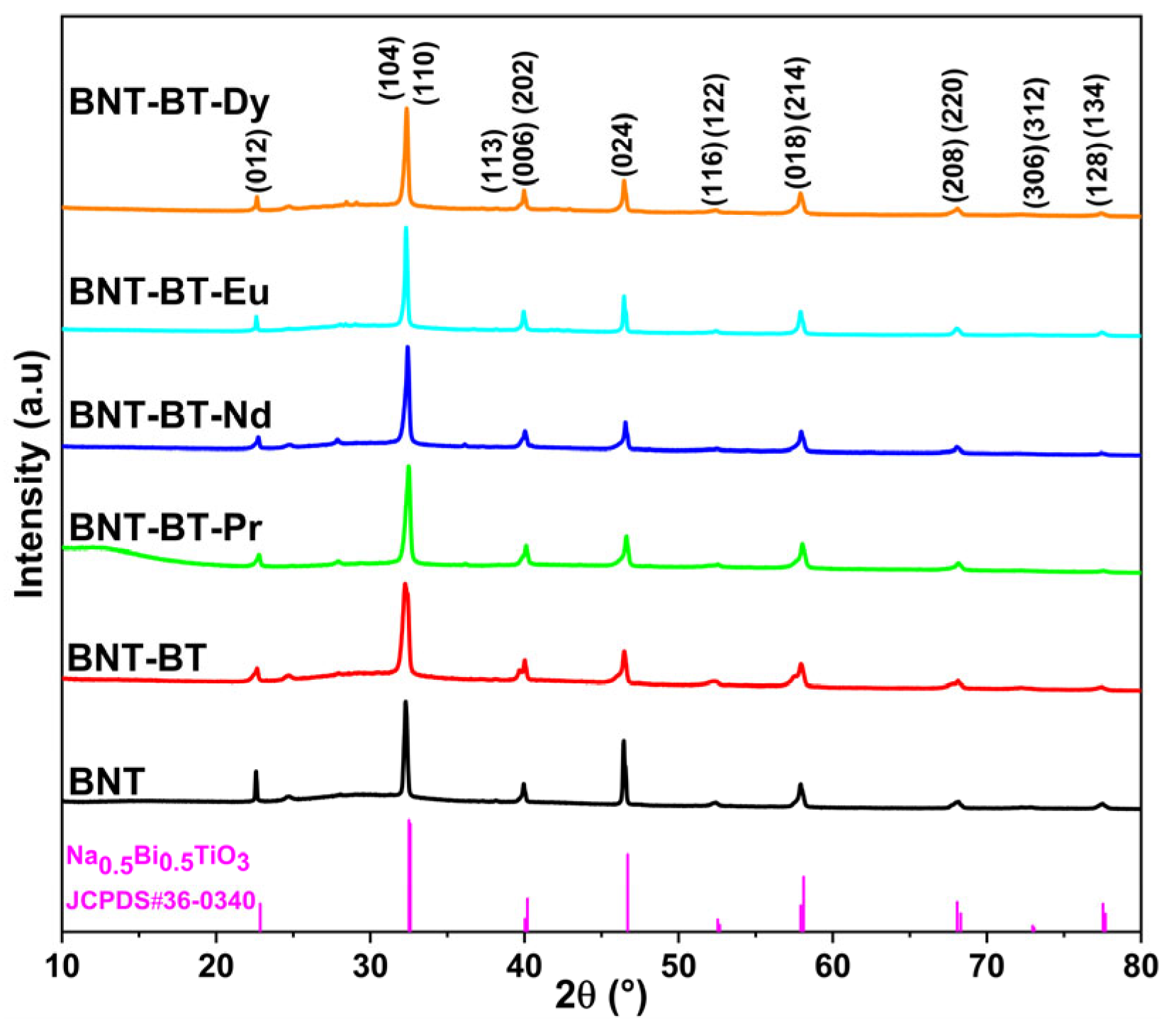
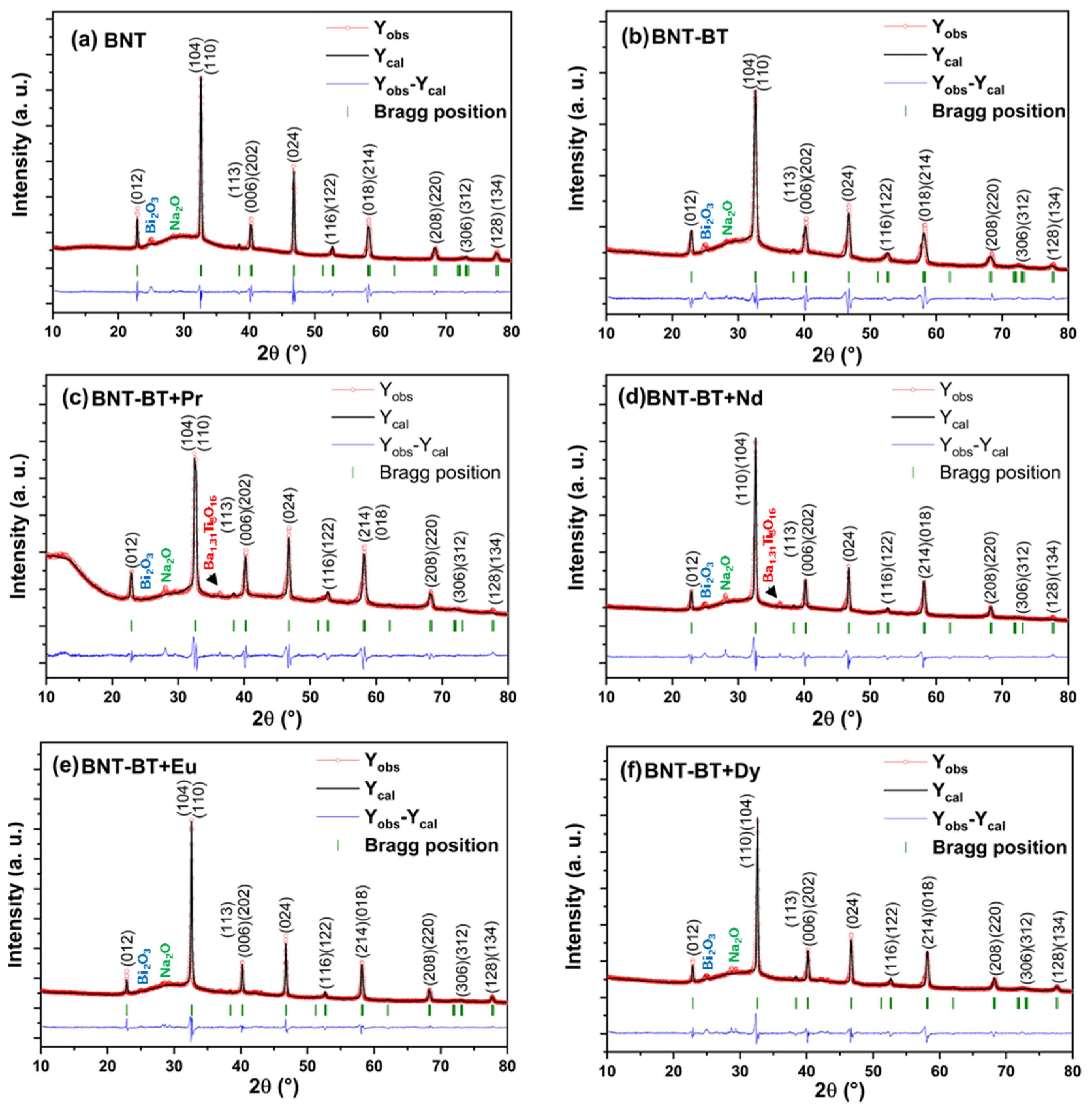
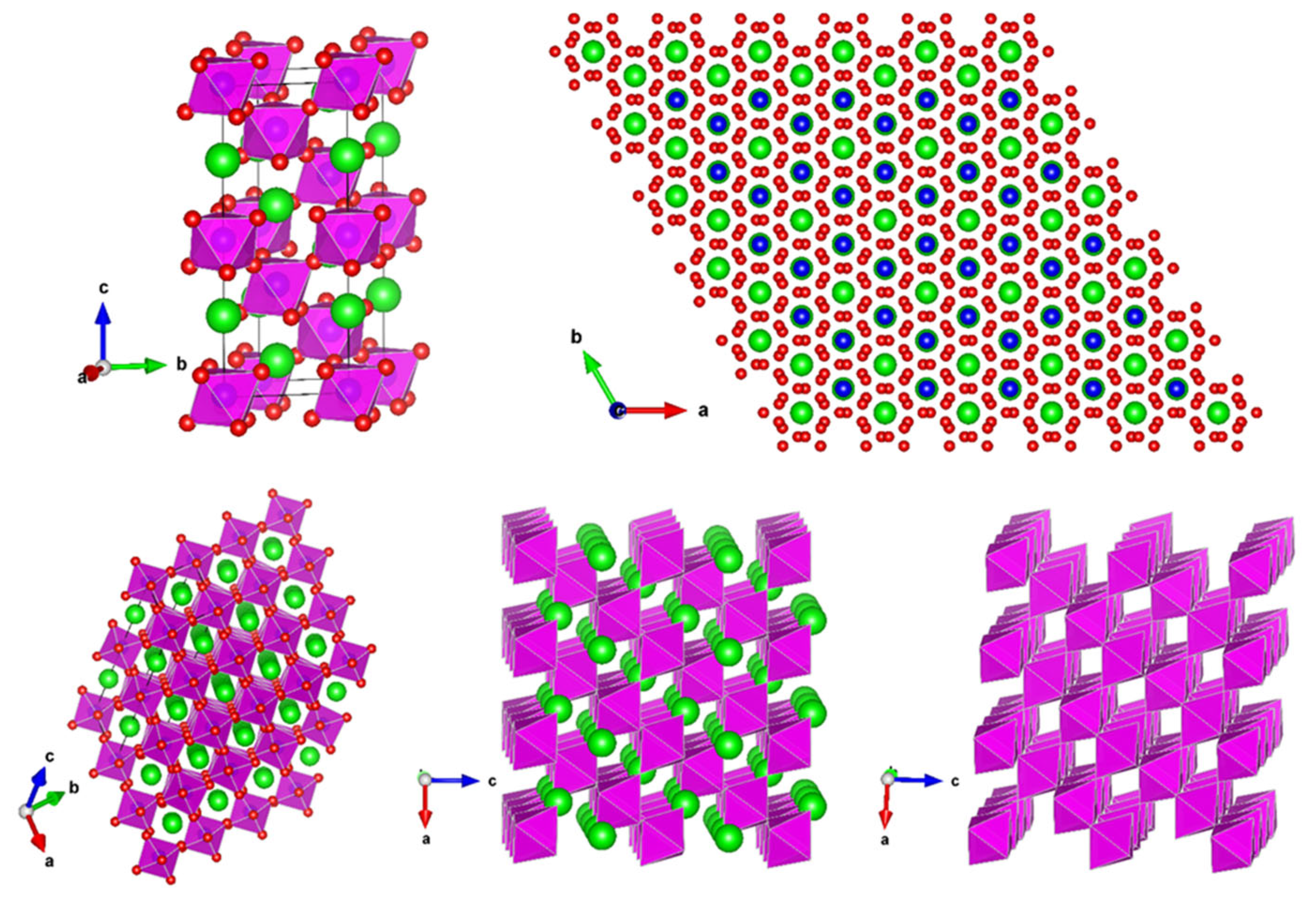
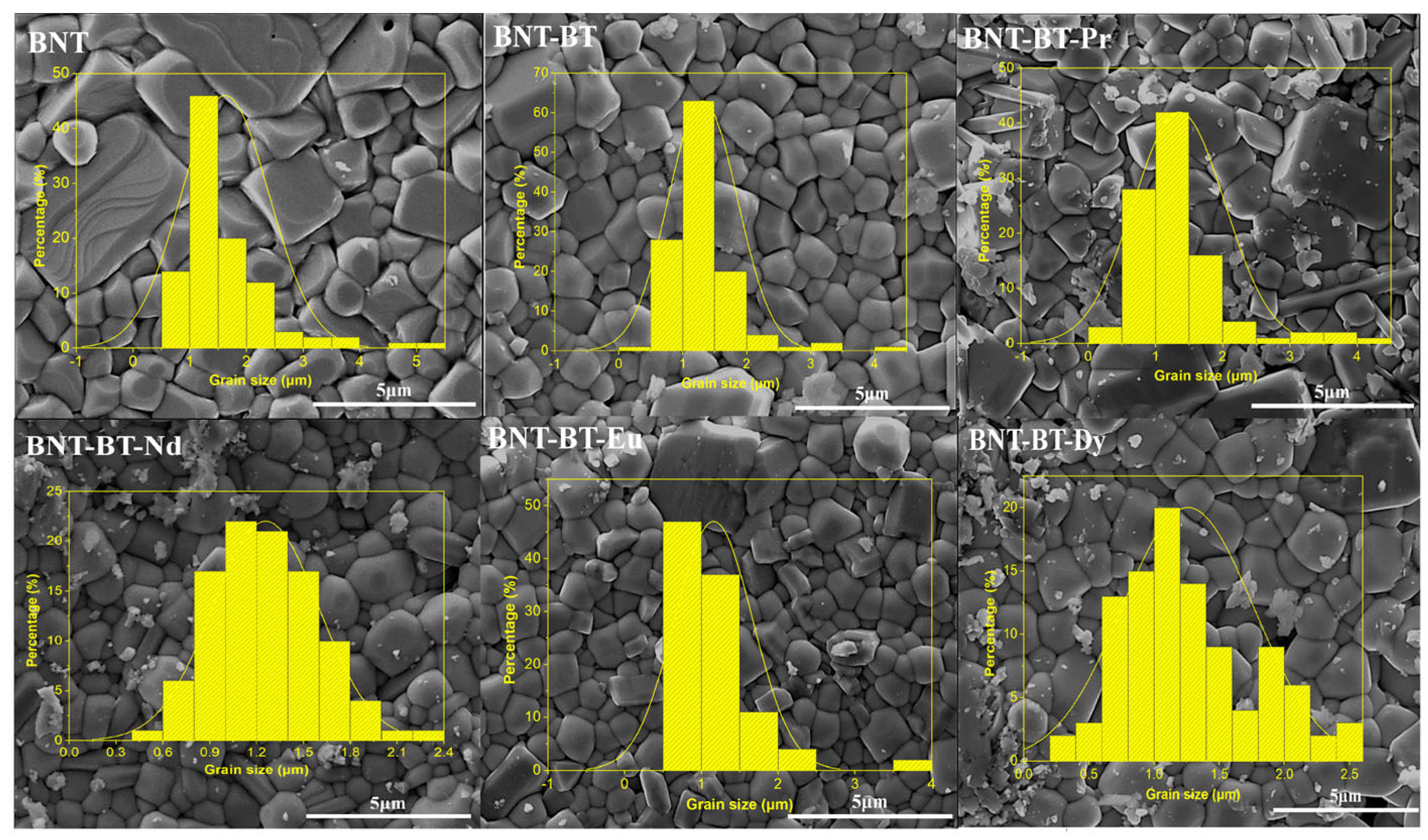
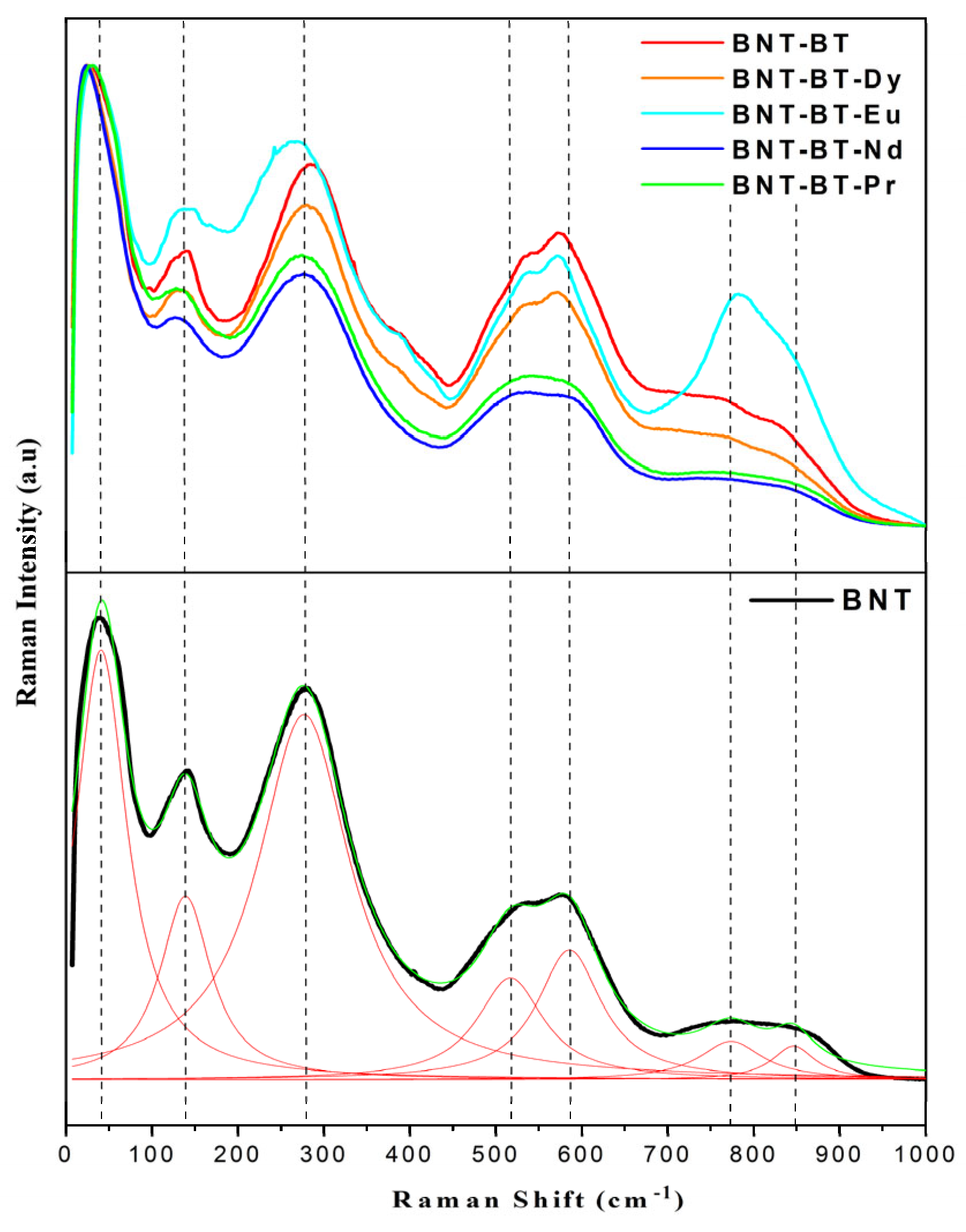
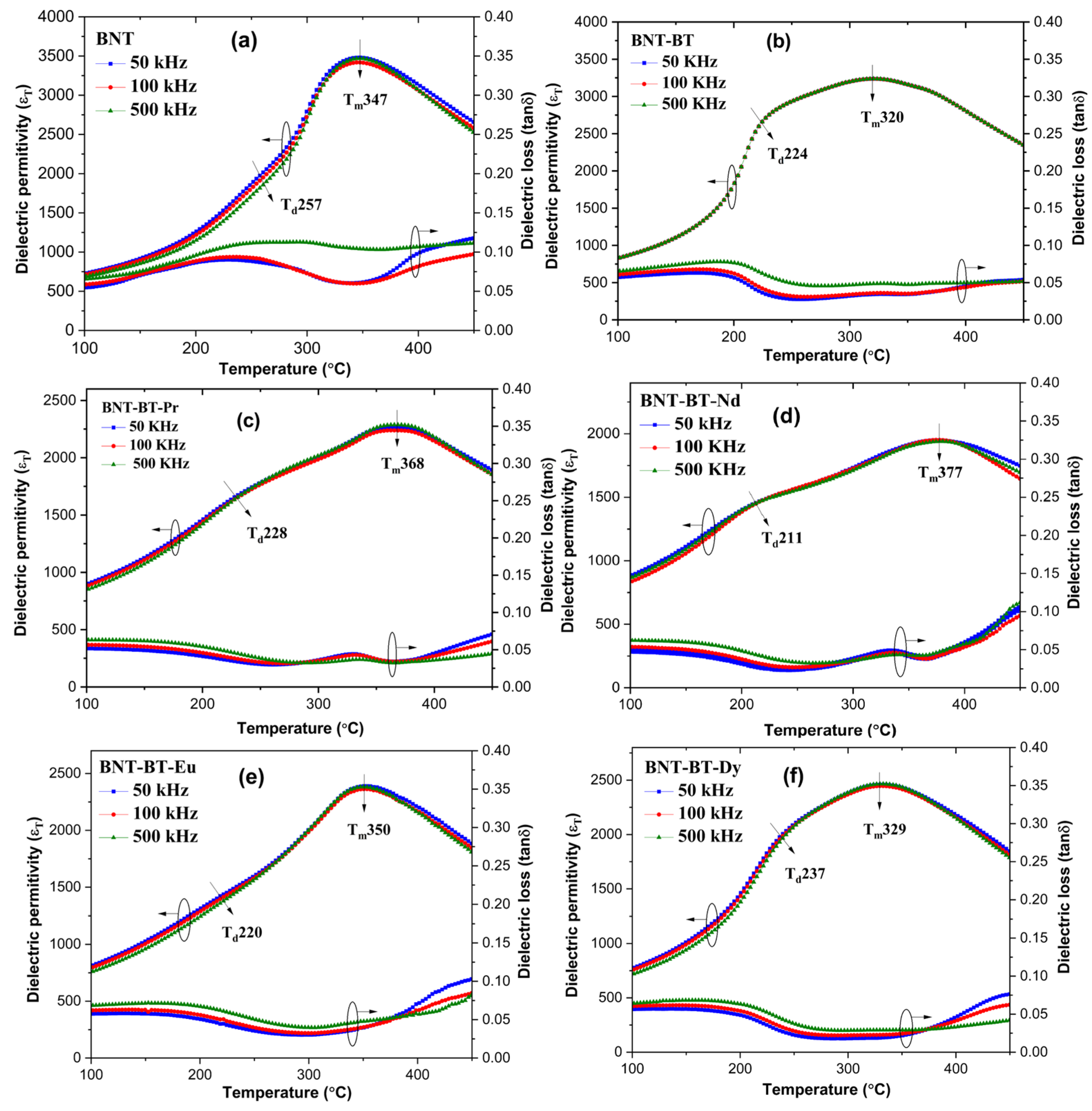
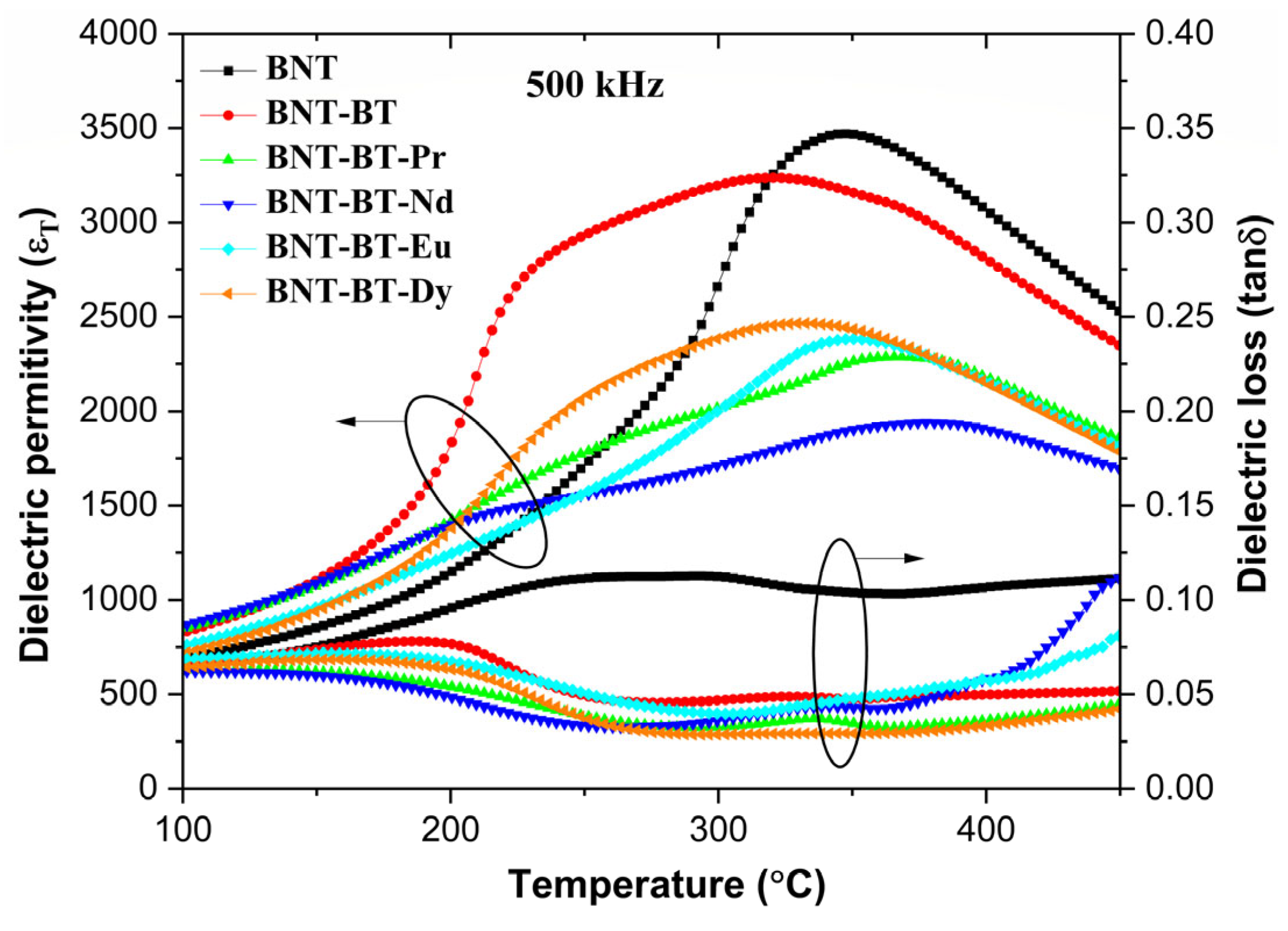
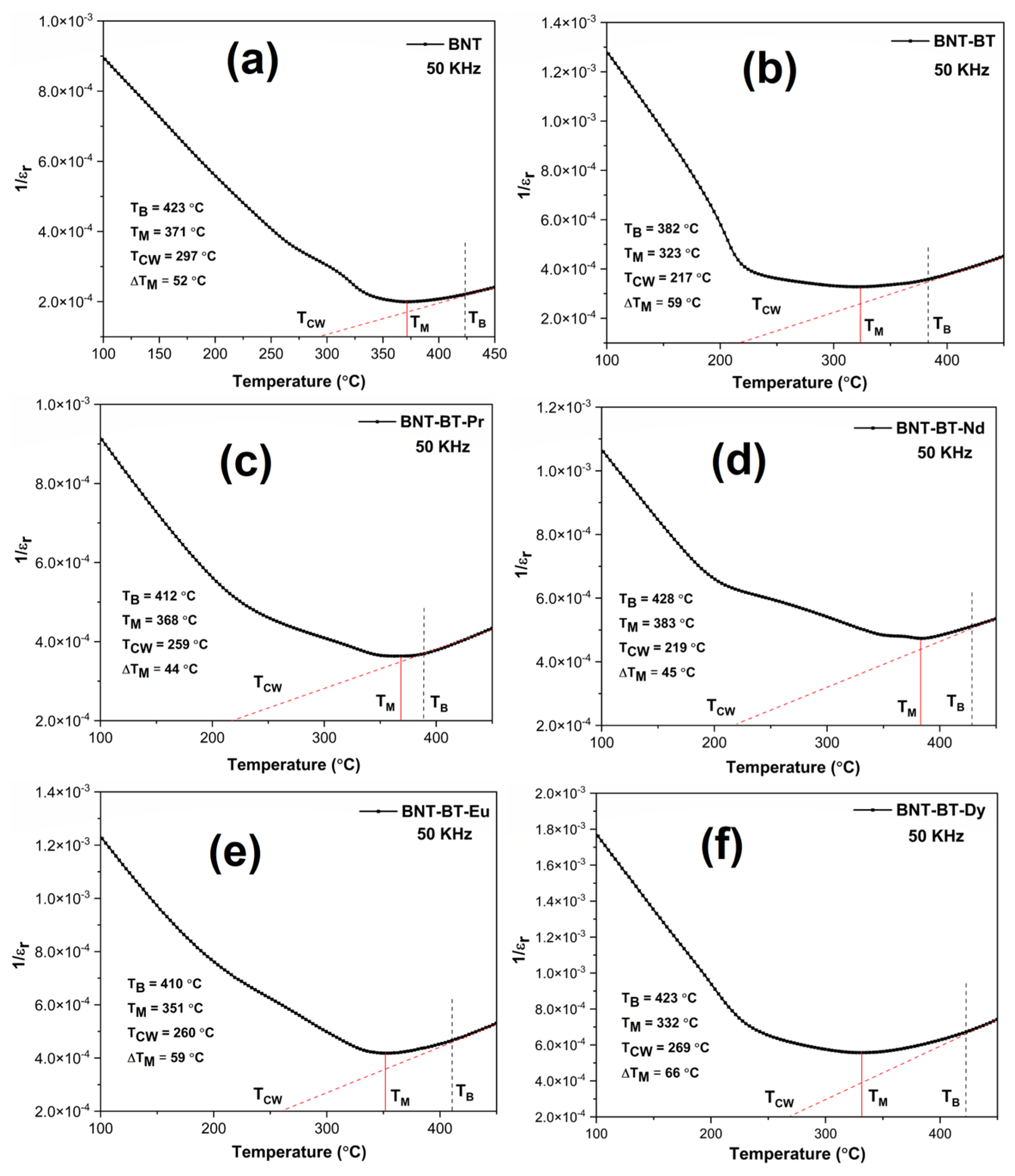
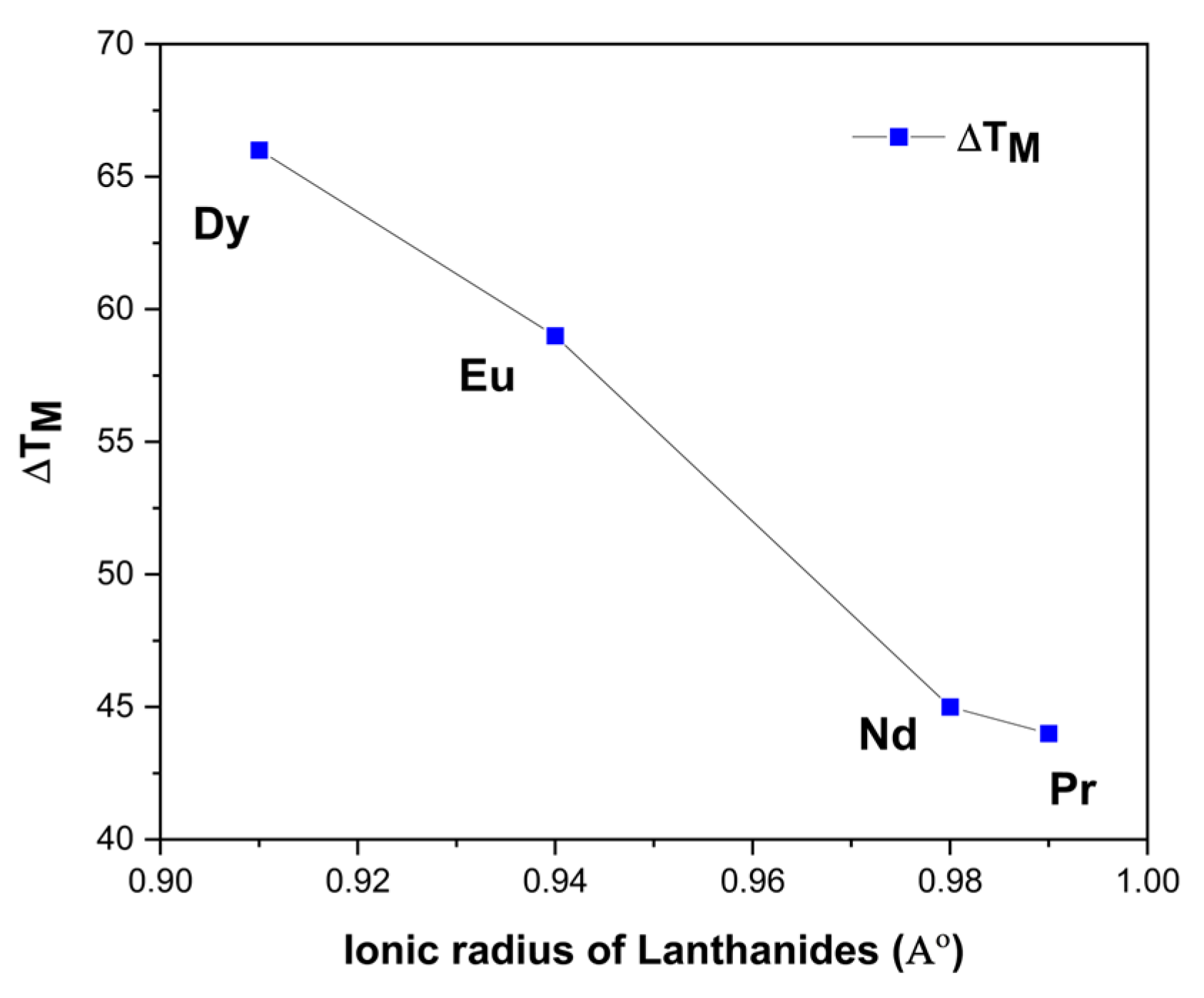
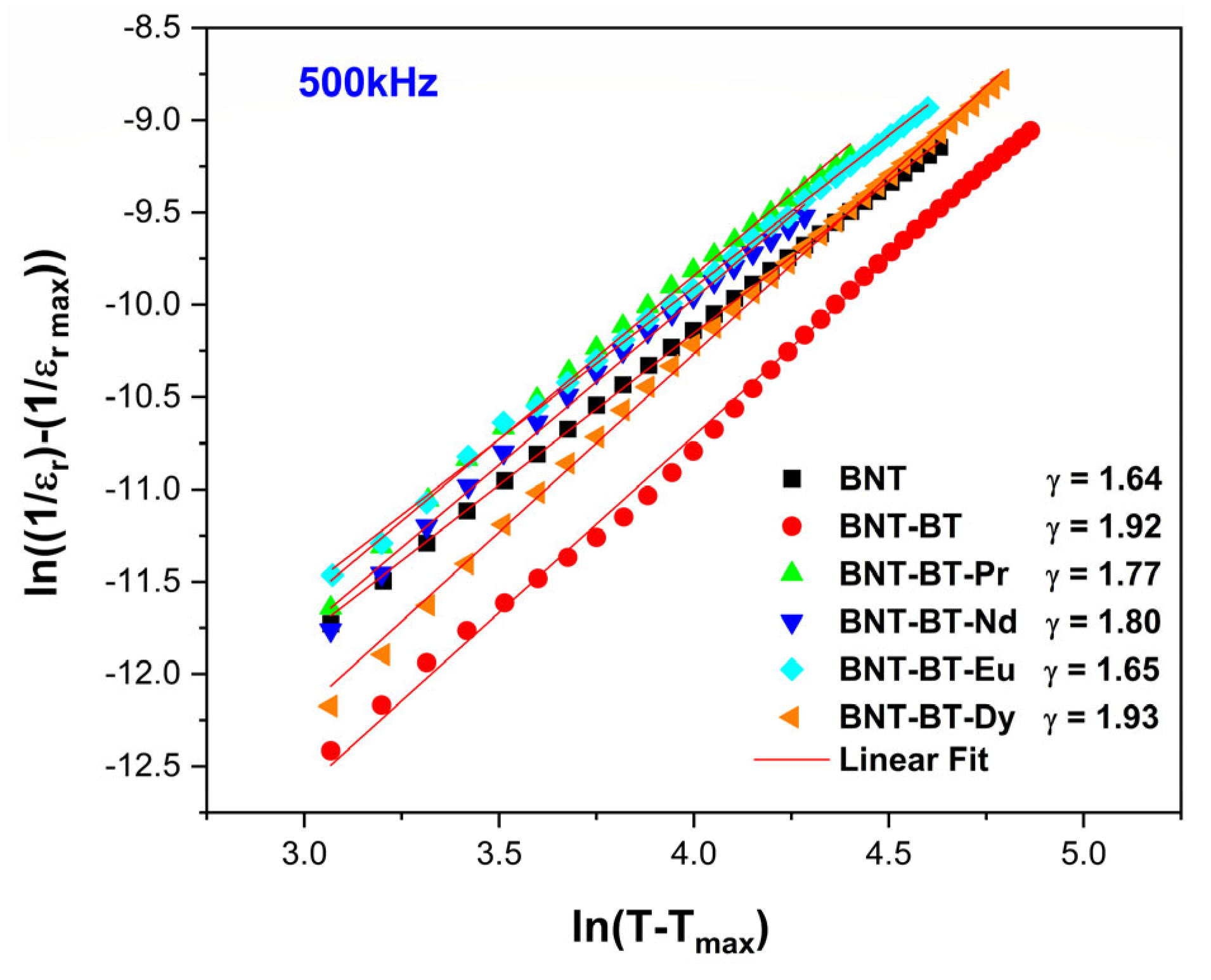
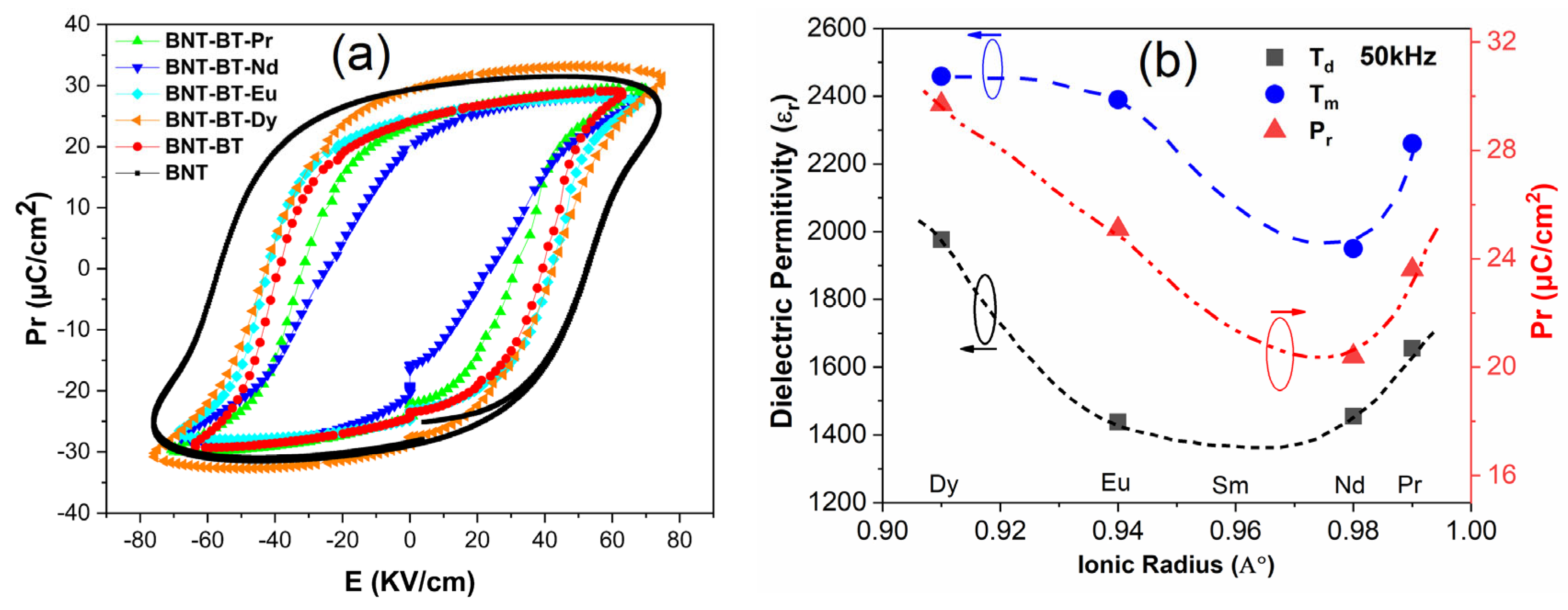
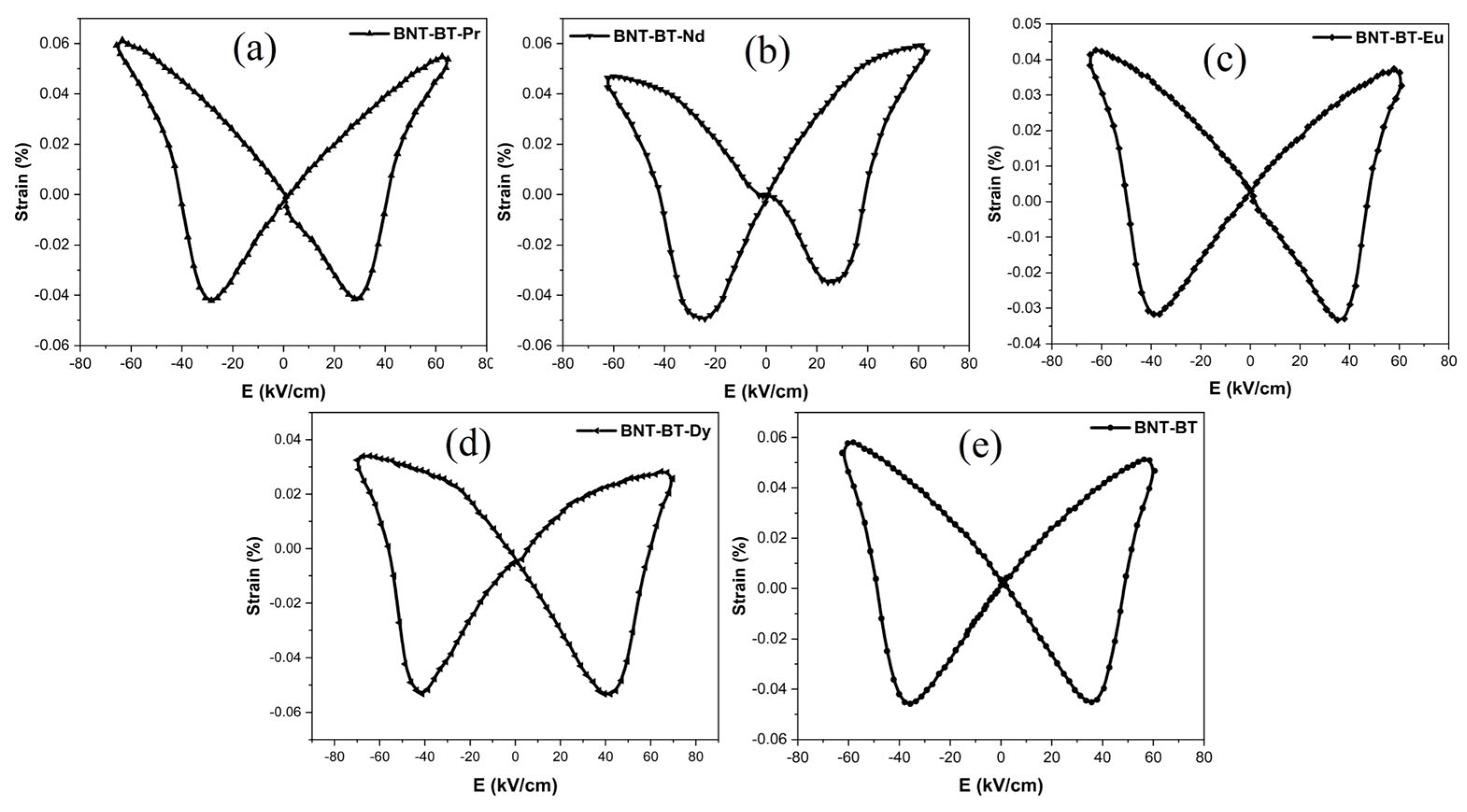
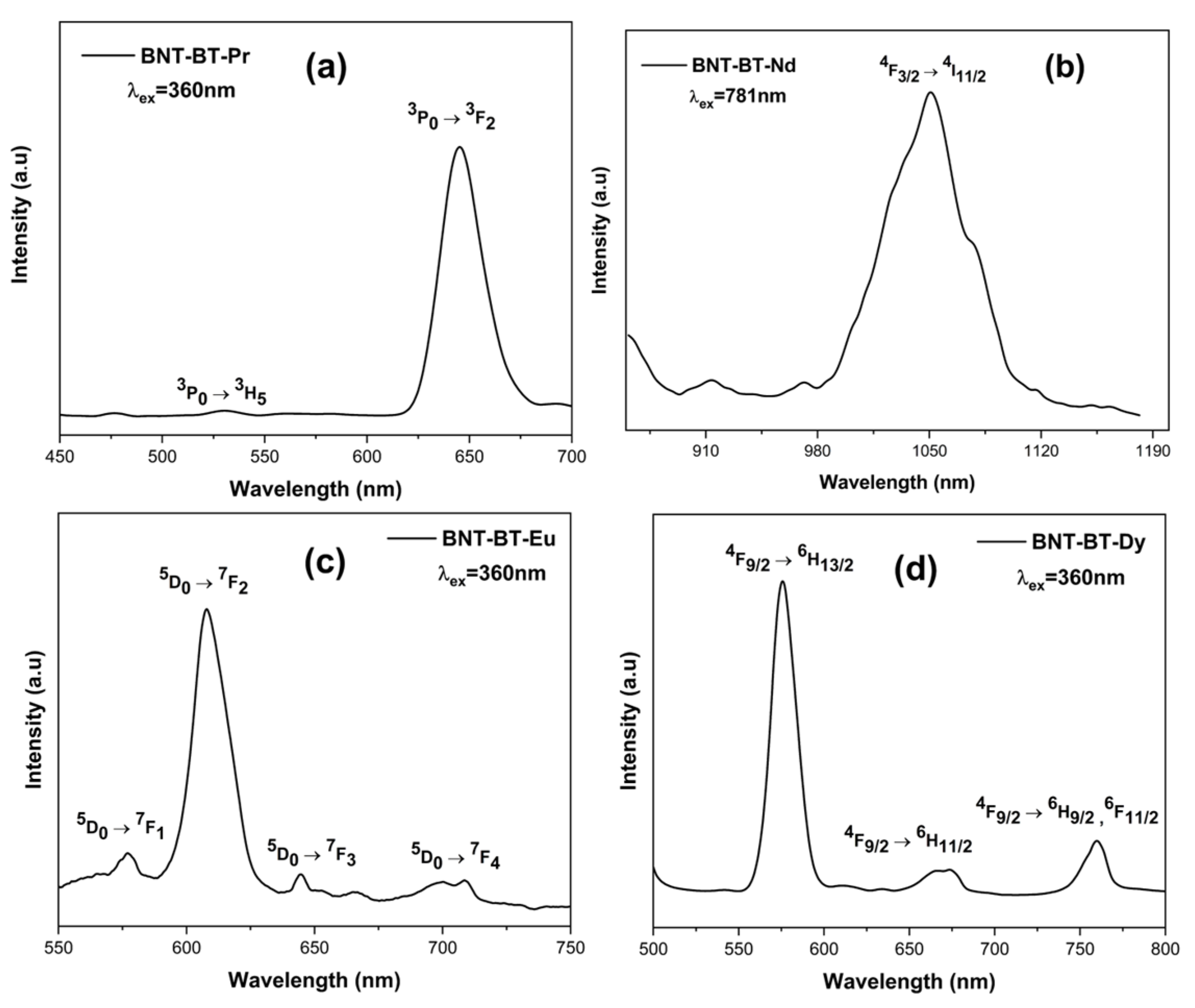
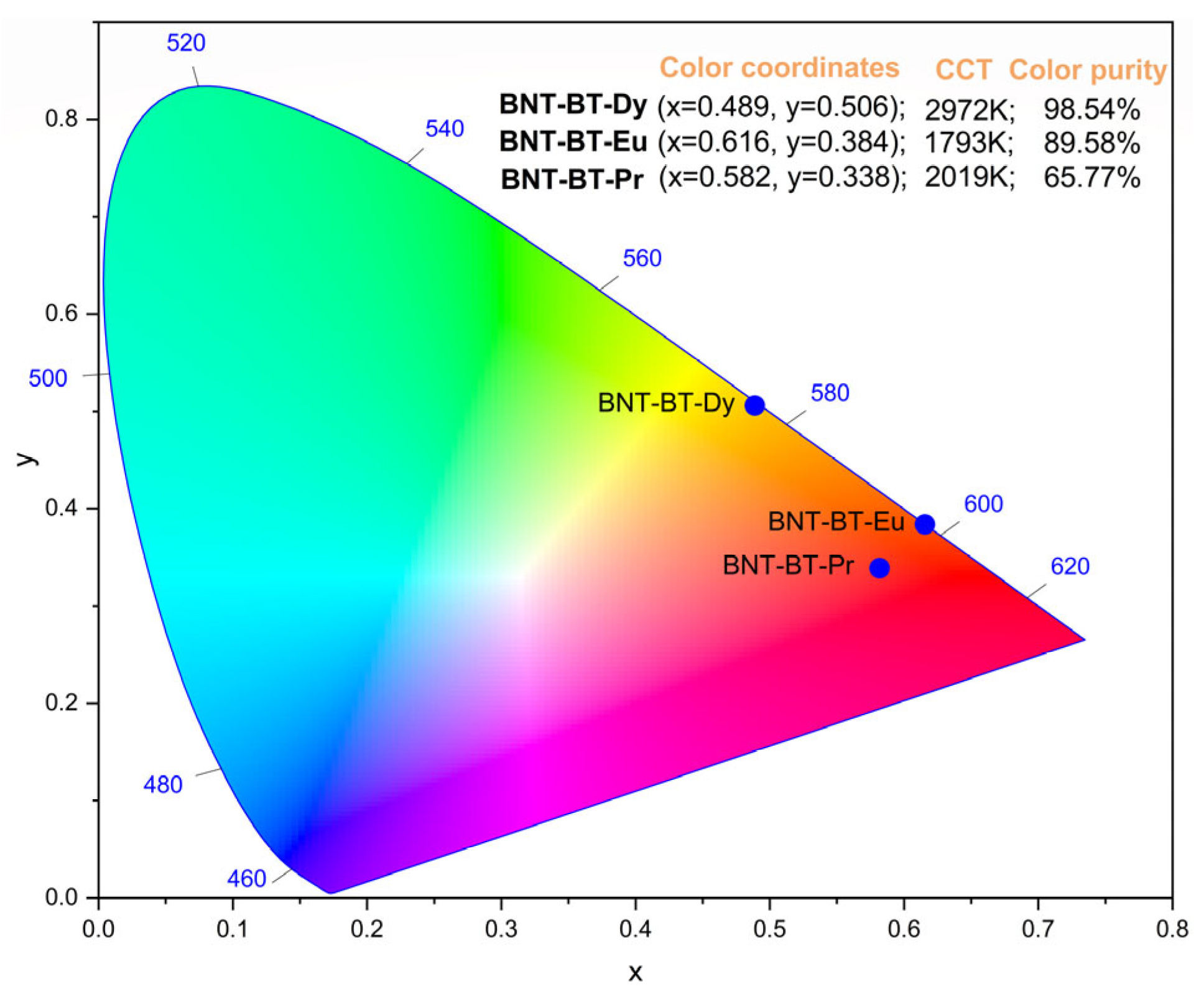
| Sample | BNT-BT-Ln (Ln = Pr3+, Nd3+, Eu3+, Dy3+) | |||||||
|---|---|---|---|---|---|---|---|---|
| Structure | Space Group | a (Å) | c (Å) | V (Å3) | Tf | Rwp | χ2 | |
| BNT | Rhombohedral structure | 5.4991 (51) | 13.4367 (22) | 351.89 (56) | 0.9187 | 10.43 | 1.38 | |
| BNT-BT | 5.4884 (25) | 13.5503 (67) | 353.49 (29) | 0.9243 | 11.47 | 1.32 | ||
| BNT-BT-Pr | 5.5005 (08) | 13.4353 (39) | 352.03 (13) | 0.9220 | 9.87 | 1.29 | ||
| BNT-BT-Nd | 5.4993 (09) | 13.4420 (46) | 352.05 (14) | 0.9220 | 11.96 | 1.31 | ||
| BNT-BT-Eu | 5.4920 (06) | 13.4426 (12) | 351.14 (06) | 0.9218 | 10.28 | 1.25 | ||
| BNT-BT-Dy | 5.5028 (06) | 13.4572 (11) | 352.90 (16) | 0.9217 | 12.17 | 1.43 | ||
| Samples | TB (°C) | TM (°C) | TCW (°C) | ΔTM (°C) |
|---|---|---|---|---|
| BNT | 423 | 371 | 297 | 52 |
| BNT-BT | 382 | 323 | 217 | 59 |
| BNT-BT-Dy | 423 | 332 | 269 | 66 |
| BNT-BT-Eu | 410 | 351 | 260 | 59 |
| BNT-BT-Nd | 428 | 383 | 219 | 45 |
| BNT-BT-Pr | 412 | 368 | 259 | 44 |
| Samples | Pr (μC/cm2) | E (kV/cm) |
|---|---|---|
| BNT | 29.5 | 73.6 |
| BNT-BT | 24.7 | 63 |
| BNT-BT-Dy | 29.7 | 74.8 |
| BNT-BT-Eu | 25.1 | 67.5 |
| BNT-BT-Nd | 20.4 | 67.1 |
| BNT-BT-Pr | 23.6 | 69.8 |
Disclaimer/Publisher’s Note: The statements, opinions and data contained in all publications are solely those of the individual author(s) and contributor(s) and not of MDPI and/or the editor(s). MDPI and/or the editor(s) disclaim responsibility for any injury to people or property resulting from any ideas, methods, instructions or products referred to in the content. |
© 2024 by the authors. Licensee MDPI, Basel, Switzerland. This article is an open access article distributed under the terms and conditions of the Creative Commons Attribution (CC BY) license (https://creativecommons.org/licenses/by/4.0/).
Share and Cite
Zidani, J.; Alaoui, I.H.; Zannen, M.; Birks, E.; Chchiyai, Z.; Majdoub, M.; Manoun, B.; El Marssi, M.; Lahmar, A. On the Lanthanide Effect on Functional Properties of 0.94Na0.5Bi0.5TiO3-0.06BaTiO3 Ceramic. Materials 2024, 17, 1783. https://doi.org/10.3390/ma17081783
Zidani J, Alaoui IH, Zannen M, Birks E, Chchiyai Z, Majdoub M, Manoun B, El Marssi M, Lahmar A. On the Lanthanide Effect on Functional Properties of 0.94Na0.5Bi0.5TiO3-0.06BaTiO3 Ceramic. Materials. 2024; 17(8):1783. https://doi.org/10.3390/ma17081783
Chicago/Turabian StyleZidani, Jacem, Ilham Hamdi Alaoui, Moneim Zannen, Eriks Birks, Zakaria Chchiyai, Mustapha Majdoub, Bouchaib Manoun, Mimoun El Marssi, and Abdelilah Lahmar. 2024. "On the Lanthanide Effect on Functional Properties of 0.94Na0.5Bi0.5TiO3-0.06BaTiO3 Ceramic" Materials 17, no. 8: 1783. https://doi.org/10.3390/ma17081783
APA StyleZidani, J., Alaoui, I. H., Zannen, M., Birks, E., Chchiyai, Z., Majdoub, M., Manoun, B., El Marssi, M., & Lahmar, A. (2024). On the Lanthanide Effect on Functional Properties of 0.94Na0.5Bi0.5TiO3-0.06BaTiO3 Ceramic. Materials, 17(8), 1783. https://doi.org/10.3390/ma17081783







